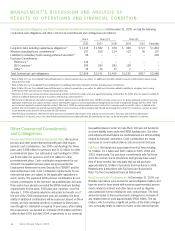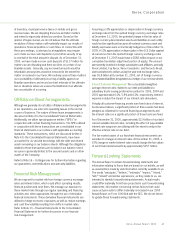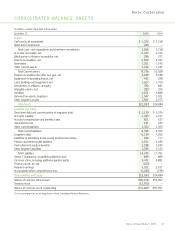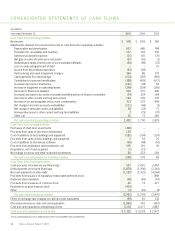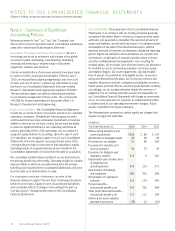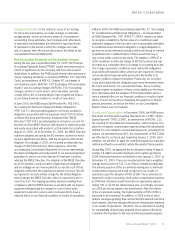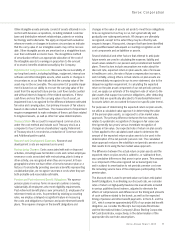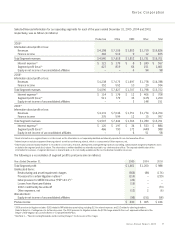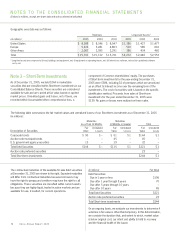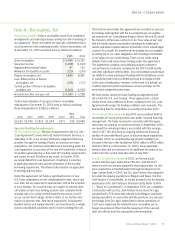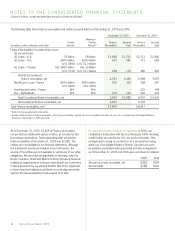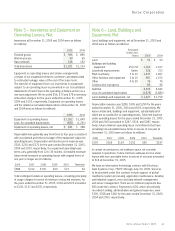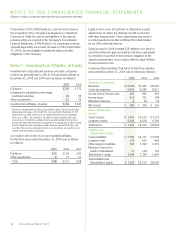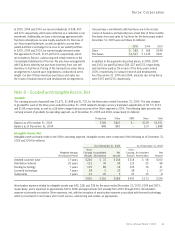Xerox 2005 Annual Report Download - page 62
Download and view the complete annual report
Please find page 62 of the 2005 Xerox annual report below. You can navigate through the pages in the report by either clicking on the pages listed below, or by using the keyword search tool below to find specific information within the annual report.
NOTES TO THE CONSOLIDATED FINANCIAL STATEMENTS
(Dollars in millions, except per-share data and unless otherwise indicated)
54
Revenues under bundled arrangements are allocated considering
the relative fair values of the lease and non-lease deliverables
included in the bundled arrangement based upon the estimated
relative fair values of each element. Lease deliverables include
maintenance and executory costs, equipment and financing,
while non-lease deliverables generally consist of the supplies and
non-maintenance services. Our revenue allocation for the lease
deliverables begins by allocating revenues to the maintenance
and executory costs plus profit thereon. The remaining amounts
are allocated to the equipment and financing elements. We perform
extensive analyses of available verifiable objective evidence of
equipment fair value based on cash selling prices during the
applicable period. The cash selling prices are compared to the
range of values included in our lease accounting systems. The
range of cash selling prices must be reasonably consistent with the
lease selling prices, taking into account residual values that accrue
to our benefit, in order for us to determine that such lease prices
areindicative of fair value. Our pricing interest rates, which areused
to determine customer lease payments, are developed based upon
avariety of factors including local prevailing rates in the market-
place and the customer’s credit history,industry and credit class.
Effective in 2004, our pricing rates are reassessed quarterly based
on changes in local prevailing rates in the marketplace and are
adjusted to the extent such rates vary by twenty-five basis points
or more, cumulatively, from the last rate in effect. The pricing
interest rates generally equal the implicit rates within the leases, as
corroborated by our comparisons of cash to lease selling prices.
Cash and Cash Equivalents: Cash and cash equivalents consist
of cash on hand, including money-market funds, and investments
with original maturities of three months or less.
Restricted Cash and Investments: Several of our secured
financing arrangements and derivative contracts, as well as other
material contracts, require us to post cash collateral or maintain
minimum cash balances in escrow. These cash amounts are
reported in our Consolidated Balance Sheets, depending on
when the cash will be contractually released. At December 31,
2005 and 2004, such restricted cash amounts were as follows
(in millions):
December 31, 2005 2004
Escrow and cash collections related
to secured borrowing arrangements $ 254 $ 372
Collateral related to risk management
arrangements 43 61
Other restricted cash 149 97
Total $ 446 $ 530
Of these amounts, $270 and $370 wereincluded in Other current
assets and $176 and $160 wereincluded in Other long-term
assets, as of December 31, 2005 and 2004, respectively.
Provisions for Losses on Uncollectible Receivables: The provi-
sions for losses on uncollectible trade and finance receivables
are determined principally on the basis of past collection
experience applied to ongoing evaluations of our receivables
and evaluations of the default risks of repayment. Allowances for
doubtful accounts on accounts receivable balances were $136
and $183, as of December 31, 2005 and 2004, respectively.
Allowances for doubtful accounts on finance receivables were
$229 and $276 at December 31, 2005 and 2004, respectively.
Inventories: Inventories are carried at the lower of average cost
or market. Inventories also include equipment that is returned at
the end of the lease term. Returned equipment is recorded at the
lower of remaining net book value or salvage value. Salvage value
consists of the estimated market value (generally determined
based on replacement cost) of the salvageable component parts,
which are expected to be used in the remanufacturing process.
We regularly review inventory quantities and record a provision for
excess and/or obsolete inventory based primarily on our estimated
forecast of product demand, production requirements and servic-
ing commitments. Several factors may influence the realizability
of our inventories, including our decision to exit a product line,
technological changes and new product development. The provision
for excess and/or obsolete raw materials and equipment
inventories is based primarily on near-term forecasts of product
demand and include consideration of new product introductions
as well as changes in remanufacturing strategies. The provision
for excess and/or obsolete service parts inventory is based
primarily on projected servicing requirements over the life of the
related equipment populations.
Land, Buildings and Equipment and Equipment on Operating
Leases: Land, buildings and equipment are recorded at cost.
Buildings and equipment are depreciated over their estimated
useful lives. Leasehold improvements aredepreciated over the
shorter of the lease term or the estimated useful life. Equipment
on operating leases is depreciated to estimated residual value
over the lease term. Depreciation is computed using the
straight-line method. Significant improvements are capitalized
and maintenance and repairs are expensed. Refer to Notes
5and 6 for further discussion.
Goodwill and Other Intangible Assets: Goodwill is tested for impair-
ment annually or more frequently if an event or circumstance
indicates that an impairment loss may have been incurred.
Application of the goodwill impairment test requires judgment,
including the identification of reporting units, assignment of
assets and liabilities to reporting units, assignment of goodwill
to reporting units, and determination of the fair value of each
reporting unit. We estimate the fair value of each reporting unit
using a discounted cash flow methodology. This requires us
to use significant judgment including estimation of future cash
flows, which is dependent on internal forecasts, estimation of
the long-term rate of growth for our business, the useful life
over which cash flows will occur, determination of our weighted
average cost of capital, and relevant market data.
Xerox Annual Report 2005


